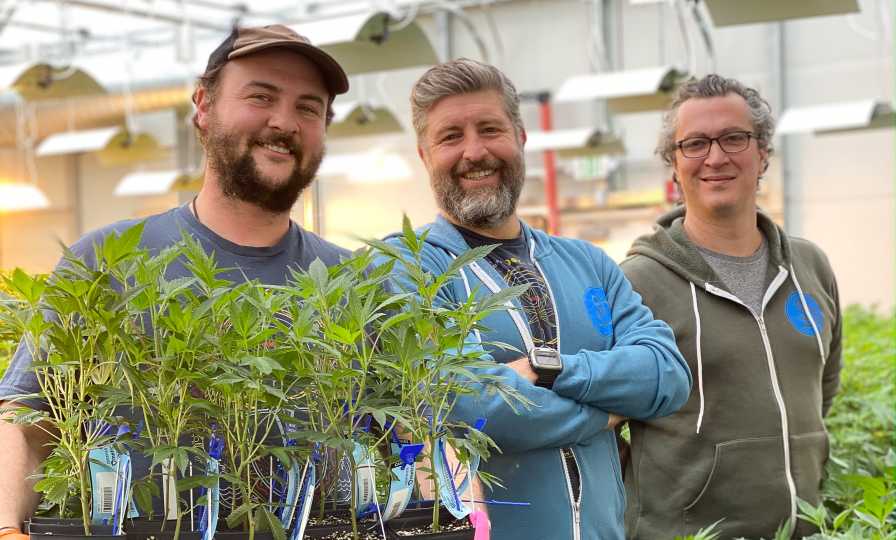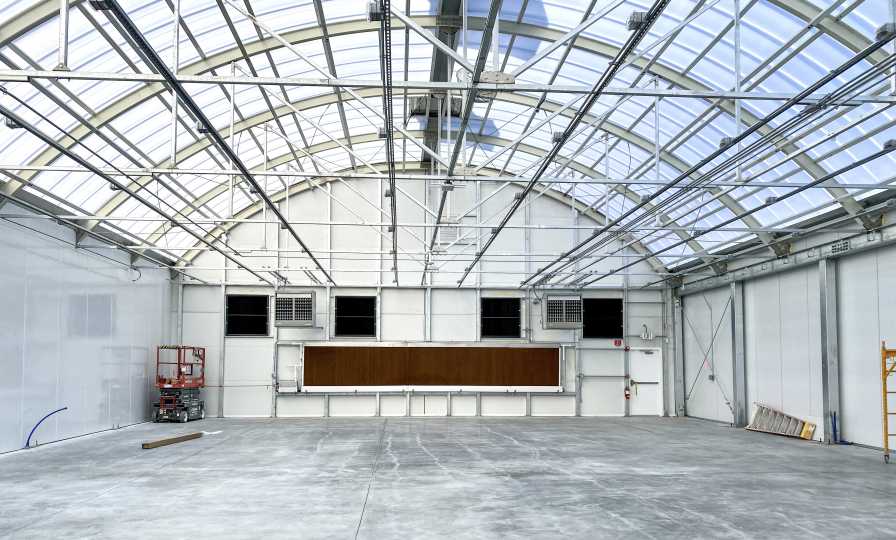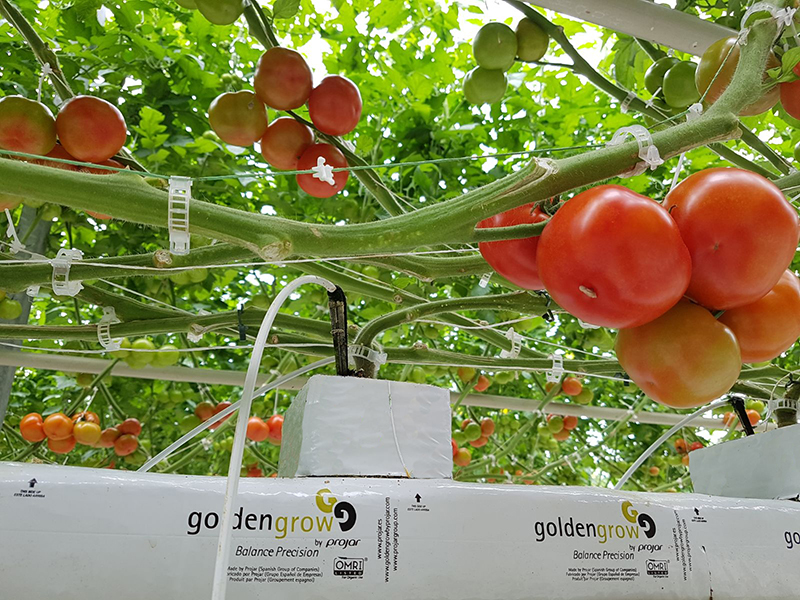How Sweet Dirt Became a Model for Sustainable Greenhouse Cannabis Production

The Sweet Dirt management team includes (from left): Hughes Pope (founder and Head of Cultivation), Jim Henry (CEO), and Justice Rines (Chief Compliance Officer).
Photos courtesy of Sweet Dirt
Since being founded in 2015, Sweet Dirt has emerged as a leading Maine-based grower and producer of organically grown cannabis flower and cannabis-induced products. The company has even earned the Maine Organic Farmers & Gardeners (MOFGA) certified clean cannabis designation, achieved by fewer than 1% of all licensed cannabis growers in Maine.
Leading the charge at Sweet Dirt are Hughes Pope (founder and Head of Cultivation), Justice Rines (Chief Compliance Officer), and Jim Henry (CEO). Together, this management team offers a great model for how to build a greenhouse cannabis operation that is poised to take advantage of future market opportunities.
Starting Over Under Cover
Sweet Dirt did not start out as a greenhouse grower, but rather as an indoor warehouse operation. That changed, however, on June 10, 2019, when a fire destroyed the company’s main production facility at its headquarters in Eliot, ME. The 4,700 square-foot building was the home to both warehouse growing and the manufacturing and extraction facility.
Upon investigation, the fire was found to be due to a faulty electric box. While the fire felt devastating to the Sweet Dirt team at the time, the company was fully insured and had a successful settlement process.
The real opportunity came from the aftermath of the fire. The decimation and subsequent removal of the building offered Sweet Dirt a clean slate. The door was opened to start fresh with the right facility for the company’s planned growth: a 32,800 square foot greenhouse that would allow Sweet Dirt to capitalize on the state-allowed maximum of 20,000 square feet of flowering canopy for optimal yield.
Why a Greenhouse System Works, Even With Challenges
Pope says the primary benefits of growing cannabis in a greenhouse are protection from the elements and the ability to integrate modern-day technologies, including lighting, filtration, and irrigation.
“I love the control we have over the crop, and the fact that we have nothing to lose and everything to gain, especially when it comes to taking advantage of natural sunlight,” Pope says.
The enhanced crop quality also makes a huge difference.
“I noticed a tremendous shift in the plant’s characteristics from a cannabinoid and oil content standpoint,” Pope says.
In a pure indoor environment, plants were testing at 20% THC and 1% terpene levels. However, in a greenhouse using mostly sunlight and high-pressure sodium lighting, the levels went up to 26% THC and almost 3% terpenes.
“The numbers are staggering and speak for themselves,” Pope says.
On the flip side, there are challenges that come with growing a cannabis crop in a greenhouse, including timing irrigation to adjust for sun movement and natural light intensity.
“We also never had to worry about aphids [before], and greenhouses are more susceptible to them as well as other aspects of Mother Nature,” Pope says.
Rines notes one more challenge that mostly involves education on production practices. Because the company has a certified clean cannabis designation, it must undergo additional scrutiny plus required state testing.
“We use a lot of inoculants and other biologicals on our plants that help fight off disease and allow the plants to grow into the best crop they can be,” Rines says.
But during testing, there is no designation between different types of residue – harmful or good.
“We are pushing for more clarification because we also want to identify what’s there and what’s not,” Rines says. “From a compliance standpoint, it’s been a big challenge.”
Building an Experienced Team
As with any emerging crop, a little knowledge goes a long way. For a crop like cannabis, where there has been little university research thanks to its federally illegal status, knowledge comes in the form of experience.
“From a research and development perspective, we’ve been able to use the hemp side of the industry to leverage third-party processor information from people who have a lot of experience working with the plant,” Pope says. “Much of that knowledge can be translated to cannabis.”
Collectively, the Sweet Dirt team and staff has more than 100 years of cultivation experience.
“We try to leverage that as well as getting outside advice from beyond the cannabis market, and that includes anything related to controlled-environment production,” Pope says.
Following this approach, Sweet Dirt has built an experienced cultivation team from the top down, and while not every team member has worked in cannabis in the past, they all have some sort of horticulture background.
“We look for a good combination of skill sets and have found that a combination of cannabis and non-cannabis experience pays dividends in terms of how we work together as a team,” Pope says. “You need a wide range of skill sets beyond the crop.”
Future Growth
Sweet Dirt CEO Jim Henry says he’s proud not only of Sweet Dirt’s commitment to clean, sustainable growing, but the fact that even during a pandemic, the company continues to thrive and add to its team.
“It’s an incredibly attractive thing for us here at Sweet Dirt to make sure we’re giving back to the community and making sure we’re driving employment in a state that is experiencing its highest unemployment level in years,” Henry says.
While Sweet Dirt has its roots in medicinal cannabis and will continue to serve that community, the company is expanding into recreational use and preparing for if and when federal legalization moves forward.
“We need to be ready from a branding, production, and personnel standpoint,” Henry says.
A Look Inside the New Greenhouse
Sweet Dirt’s new facility features eight flower and cultivation rooms, and 720 standing rib twin wall polycarbonate panels that both insulate and diffuse light. More than 230 high-pressure sodium lights are staggered throughout the flower rooms and are designed to mimic the sun’s rays.
“We chose to go with high-pressure sodium lighting because it’s a tried-and-true technology and, being in New England, we really appreciate the added heat during those months of the year when it’s very cold,” Pope says. “The lamps are designed for low ceilings, so we went with a smaller reflector and a bigger light, which allows us to get roughly 24 inches away from the canopy in the winter months with a 1,100-watt lamp.”

Sweet Dirt is experimenting with different heating systems. Its new greenhouse is divided into two sections, one sealed with an HVAC system that circulates air flow from the ground up, and the other using wet walls (pictured) to move air flow horizontally.
Photo courtesy of Sweet Dirt
Henry says this gives the company the flexibility to manipulate radiant heat patterns.
Sweet Dirt is also experimenting with different heating systems. The greenhouse is divided into two sections, one sealed with an HVAC system that circulates air flow from the ground up, and the other using wet walls to move air flow horizontally.
“We did this to mitigate risk, and it’s become almost a competition to see which system works best,” Pope says.
The real nerve center of the operation, however, is a new Agriware Microsoft native ERP system. Still in the early stages of implementation, it will ultimately drive everything in cultivation and provide granular data as to how the facility is performing.
“We want to have reliable data that helps us drive product efficiencies and product quality,” says Rines, who notes the company has hired a new Director of Information Systems who will manage the technology and leverage the data compiled from the system to make informed decisions about nutrition, irrigation, and even variety selection.
“From a technology standpoint, it’s kind of dreamy,” Rines says. “We’re able to leverage analytical tools that can help us quickly make informed decisions that we wouldn’t otherwise be able to do at our scale.”
Local Appeal
You don’t often hear the phrases “cannabis production” and “locally grown” together — unless you’re at Sweet Dirt. That’s because the management team at the Maine-based operation is proud it can provide a product not just to Maine residents, but to visitors.
“Brands that come out of Maine are often linked to the state, whether it’s lobsters or blueberries, and we think cannabis can be that next great product,” says Henry. “We were the first state to decriminalize cannabis, and since then we’ve been a trailblazer for cannabis reform.”
There’s also the tourism factor to consider. During peak season, the state’s population jumps from between 1 and 2 million permanent residents to nearly 38 million people in the form of tourists, many of whom are looking for a locally produced product to enjoy during their stay.
“We are proud of how the state embraces its brands, and when you throw in the fact that we have a lot of people who want to visit every year, I think that’s why you hear us talk about the locality of this industry,” Henry says.










